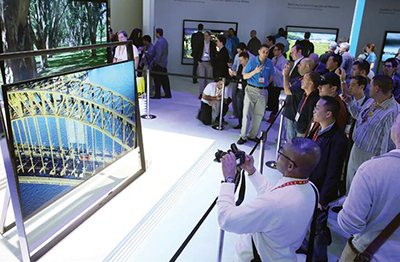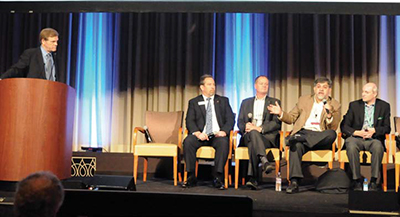4KTV: The Devil Is in the Details

UHDTVs are expected to be a big seller this holiday season. But where’s the UHD content?
HOLLYWOOD—You can already buy several models of 4KTVs (“4K” in this case stands for a resolution of 3840x2160 pixels, more accurately described as Quad HD or 2160p), starting with super-cheap models from Chinese brands like TCL and continuing with higher- priced versions from Samsung, Sony, Sharp, LG, and Panasonic.
However, as you might have guessed, the UHDTV delivery system is far from complete, and there are already some significant technical obstacles to overcome: The first is the new HDMI 2.0 standard, which is barely fast enough to deliver Quad HD content at 60 Hz, using 8-bit color. The consensus of presenters, panelists, and attendees at the SMPTE Technology Conference 4K session recently was that 8-bit color is inadequate for UHDTV, and that 10-bit and preferably 12-bit color should be used in a full 4:4:4 (RGB) delivery format.
That’s not difficult to do if the source frame rate is 24 Hz, but it will be impossible with fast frame rates over HDMI 2.0. And higher frame rates, plus high dynamic range and deep color, are seen as the real attractions to 4K, according to SMPTE presenters and panelists. So, before UHDTV is even out of the gate, there is already a major connectivity obstacle.
You’ll also discover a growing belief among video professionals that it’s finally time to ditch the “backwards-compatible” obsession that has dogged our television systems since NTSC color was standardized 60 years ago.
For UHDTV, this would mean moving exclusively to RGB color, dropping fractional frame rates, and burying interlaced scanning for good as the new UHDTV ecosystem is developed. This sounds like a great idea on paper, but it raises plenty of questions with respect to signal format conversion.
Right now, we have a hodge-podge of broadcast and video formats coming into our 2K-resolution LCD and plasma TVs, including 480i, 480p, 720p, 1080i, and 1080p delivered through MPEG4 H.264 encoding. How will each of those look on a UHDTV?
Upscaling 1080p content appears to be the easiest task, as horizontal and vertical resolution are both doubled using straight pixel interpolation and no de-interlacing is required. Most 1080p content originates from optical disc or streaming sources and comes with slow frame rates (read: movies).
The professional video industry's #1 source for news, trends and product and tech information. Sign up below.
EXISTING CONTENT
But things aren’t quite so simple with high frame rate sources, such as live 60Hz programming. Presently, all of that originates as either a 720p/60 broadcast or a 1080i/30 broadcast. Jumping from 720p to 2160p requires tripling the number of pixels in both axes, plus performing motion interpolation for the two additional pixels. 1080i adds the burden of de-interlacing to the process.
And how does upconverted 720p and 1080i programming look? Not as bad as you might think, but it’s definitely a step down from native 4:4:4 2160p content, as demonstrated at the SMPTE event by several manufacturers of video processors. Think of the difference between 480i composite video and 1080p 4:2:2, and you get the idea.

The writer leads a session on 4K delivery at SMPTE last month. And as we all know, there is still a lot of 480i source material out there, particularly on secondary minor channels like “Antenna TV” and “This TV.” These channels specialize in “good old days” programming from the 50’s, 60’s, 70’s, and even the 80’s; all formatted to 4:3 and all using interlaced black-and-white and color formats.
How big is the jump from 480i to 2160p? Assuming a clean de-interlacing job, the pixels need to be interpolated 4.5 times. (And they’re in the wrong aspect ratio to begin with.) Add in the fact that you really want to sit closer to a UHDTV screen to get the immersive viewing experience, and you’ll quickly realize that NTSC should be buried for good.
While Blu-ray advocates work on a new standard for 2160p/Quad HD authoring, there’s a new source for 4K content delivery: Streaming. Amazing as it may seem, Netflix is already testing 4K movie delivery and plans to roll it out next year for premium subscribers. Netflix CEO Reid Hastings said a few months back that 15 Mbps is their targeted streaming rate for 4K, and “. . .If you have a 50 Mbps broadband connection, you’ll be fine.”
The new H.265 High-Efficiency Video Codec will make it possible to stream/play back 2160p video at data rates comparable to those currently used for 1080p; in the range of 10–20 Mbps. (HEVC will also increase the use of 1080p streaming at the expense of 480p and 720p). The first HEVC chips from Broadcom are being evaluated now, but we won’t see a wide roll-out of H.265 decoding in consumer products until later next year. Netflix is undoubtedly relying on HEVC to enable 4K streaming, as will Blu-ray and other physical media platforms.
To summarize; we’ve got plenty of UHDTVs to choose from, with more coming each month at surprisingly affordable prices. And they’re all big-screen sets (starting at 50 inches and going up from there). But, their display interfaces aren’t fast enough to support 2160p video at high frame rates and deeper color, nor are they likely to be any time soon. And aside from expensive, pre-loaded media players, there aren’t any sources of true UHDTV content to watch.
Pete Putman, CTS, KT2B, is the president of ROAM Consulting.

